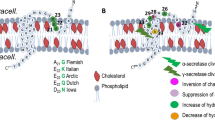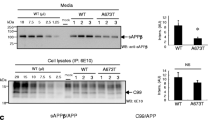Abstract
A common pathogenic event that occurs in all forms of Alzheimer’s disease is the progressive accumulation of amyloid β-peptide (Aβ) in brain regions responsible for higher cognitive functions. Inhibition of acyl-coenzyme A: cholesterol acyltransferase (ACAT), which generates intracellular cholesteryl esters from free cholesterol and fatty acids, reduces the biogenesis of the Aβ from the amyloid precursor protein (APP). Here we have used AC29 cells, defective in ACAT activity, to show that ACAT activity steers APP either toward or away from a novel proteolytic pathway that replaces both α and the amyloidogenic β cleavages of APP. This alternative pathway involves a novel cleavage of APP holoprotein at Glu281, which correlates with reduced ACAT activity and Aβ generation in AC29 cells. This sterol-dependent cleavage of APP occurs in the endosomal compartment after internalization of cell surface APP. The resulting novel C-terminal fragment APP-C470 is destined to proteasomal degradation limiting the availability of APP for the Aβ generating system. The proportion of APP molecules that are directed to the novel cleavage pathway is regulated by the ratio of free cholesterol and cholesteryl esters in cells. These results suggest that subcellular cholesterol distribution may be an important regulator of the cellular fate of APP holoprotein and that there may exist several competing proteolytic systems responsible for APP processing within the endosomal compartment.




Similar content being viewed by others
References
Abad-Rodriguez, J., Ledesma, M. D., Craessaerts, K., Perga, S., Medina, M., Delacourte, A., et al. (2004). Neuronal membrane cholesterol loss enhances amyloid peptide generation. Journal of Cell Biology, 167, 953–960. doi:10.1083/jcb.200404149.
Abbenante, G., Kovacs, D. M., Leung, D. L., Craik, D. J., Tanzi, R. E., & Fairlie, D. P. (2000). Inhibitors of beta-amyloid formation based on the beta-secretase cleavage site. Biochemical and Biophysical Research Communications, 268, 133–135. doi:10.1006/bbrc.2000.2098.
Boerwinkle, E., Visvikis, S., Welsh, D., Steinmetz, J., Hanash, S. M., & Sing, C. F. (1987). The use of measured genotype information in the analysis of quantitative phenotypes in man. II. The role of the apolipoprotein E polymorphism in determining levels, variability, and covariability of cholesterol, beta-lipoprotein, and triglycerides in a sample of unrelated individuals. American Journal of Medical Genetics, 27, 567–582. doi:10.1002/ajmg.1320270310.
Brown, M. S., & Goldstein, J. L. (1999). A proteolytic pathway that controls the cholesterol content of membranes, cells, and blood. Proceedings of the National Academy of Sciences of the United States of America, 96, 11041–11048. doi:10.1073/pnas.96.20.11041.
Burns, M., Gaynor, K., Olm, V., Mercken, M., LaFrancois, J., Wang, L., et al. (2003). Presenilin redistribution associated with aberrant cholesterol transport enhances beta-amyloid production in vivo. Journal of Neuroscience, 23, 5645–5649.
Cadigan, K. M., Heider, J. G., & Chang, T. Y. (1988). Isolation and characterization of Chinese hamster ovary cell mutants deficient in acyl-coenzyme A:cholesterol acyltransferase activity. Journal of Biological Chemistry, 263, 274–282.
Chang, T. Y., Chang, C. C., Ohgami, N., & Yamauchi, Y. (2006). Cholesterol sensing, trafficking, and esterification. Annual Review of Cell and Developmental Biology, 22, 129–157. doi:10.1146/annurev.cellbio.22.010305.104656.
Corder, E. H., Saunders, A. M., Strittmatter, W. J., Schmechel, D. E., Gaskell, P. C., Small, G. W., et al. (1993). Gene dose of apolipoprotein E type 4 allele and the risk of Alzheimer’s disease in late onset families [see comments]. Science, 261, 921–923. doi:10.1126/science.8346443.
Cutler, R. G., Pedersen, W. A., Camandola, S., Rothstein, J. D., & Mattson, M. P. (2002). Evidence that accumulation of ceramides and cholesterol esters mediates oxidative stress-induced death of motor neurons in amyotrophic lateral sclerosis. Annals of Neurology, 52, 448–457. doi:10.1002/ana.10312.
Ehnholm, C., Lukka, M., Kuusi, T., Nikkila, E., & Utermann, G. (1986). Apolipoprotein E polymorphism in the Finnish population: gene frequencies and relation to lipoprotein concentrations. Journal of Lipid Research, 27, 227–235.
Fassbender, K., Simons, M., Bergmann, C., Stroick, M., Lutjohann, D., Keller, P., et al. (2001). Simvastatin strongly reduces levels of Alzheimer’s disease beta-amyloid peptides Abeta 42 and Abeta 40 in vitro and in vivo. Proceedings of the National Academy of Sciences of the United States of America, 98, 5856–5861. doi:10.1073/pnas.081620098.
Fitzky, B. U., Moebius, F. F., Asaoka, H., Waage-Baudet, H., Xu, L., Xu, G., et al. (2001). 7-Dehydrocholesterol-dependent proteolysis of HMG-CoA reductase suppresses sterol biosynthesis in a mouse model of Smith-Lemli-Opitz/RSH syndrome. Journal of Clinical Investigation, 108, 905–915.
Frears, E. R., Stephens, D. J., Walters, C. E., Davies, H., & Austen, B. M. (1999). The role of cholesterol in the biosynthesis of beta-amyloid. Neuroreport, 10, 1699–1705. doi:10.1097/00001756-199906030-00014.
Glenner, G. G., & Wong, C. W. (1984). Alzheimer’s disease: Initial report of the purification and characterization of a novel cerebrovascular amyloid protein. Biochemical and Biophysical Research Communications, 120, 885–890. doi:10.1016/S0006-291X(84)80190-4.
Grimm, M. O., Grimm, H. S., Patzold, A. J., Zinser, E. G., Halonen, R., Duering, M., et al. (2005). Regulation of cholesterol and sphingomyelin metabolism by amyloid-beta and presenilin. Nature Cell Biology, 7, 1118–1123.
Haass, C. (2004). Take five-BACE and the gamma-secretase quartet conduct Alzheimer’s amyloid beta-peptide generation. EMBO Journal, 23, 483–488. doi:10.1038/sj.emboj.7600061.
Hutter-Paier, B., Huttunen, H. J., Puglielli, L., Eckman, C. B., Kim, D. Y., Hofmeister, A., et al. (2004). The ACAT inhibitor CP-113,818 markedly reduces amyloid pathology in a mouse model of Alzheimer’s disease. Neuron, 44, 227–238. doi:10.1016/j.neuron.2004.08.043.
Huttunen, H. J., Greco, C., & Kovacs, D. M. (2007a). Knockdown of ACAT-1 reduces amyloidogenic processing of APP. FEBS letters, 581, 1688–1692. doi:10.1016/j.febslet.2007.03.056.
Huttunen, H. J., Guenette, S. Y., Peach, C., Greco, C., Xia, W., Kim, D. Y., et al. (2007b). HtrA2 regulates beta-amyloid precursor protein (APP) metabolism through endoplasmic reticulum-associated degradation. Journal of Biological Chemistry, 282, 28285–28295. doi:10.1074/jbc.M702951200.
Jarvik, G. P., Wijsman, E. M., Kukull, W. A., Schellenberg, G. D., Yu, C., & Larson, E. B. (1995). Interactions of apolipoprotein E genotype, total cholesterol level, age, and sex in prediction of Alzheimer’s disease: a case-control study. Neurology, 45, 1092–1096 Medline.
Jick, H., Zornberg, G. L., Jick, S. S., Seshadri, S., & Drachman, D. A. (2000). Statins and the risk of dementia. Lancet, 356, 1627–1631. doi:10.1016/S0140-6736(00)03155-X.
Kang, J., Lemaire, H. G., Unterbeck, A., Salbaum, J. M., Masters, C. L., Grzeschik, K. H., et al. (1987). The precursor of Alzheimer’s disease amyloid A4 protein resembles a cell-surface receptor. Nature, 325, 733–736. doi:10.1038/325733a0.
Koudinov, A. R., Berezov, T. T., Kumar, A., & Koudinova, N. V. (1998). Alzheimer’s amyloid beta interaction with normal human plasma high density lipoprotein: Association with apolipoprotein and lipids. Clinica Chimica Acta, 270, 75–84. doi:10.1016/S0009-8981(97)00207-6.
Kuo, Y. M., Emmerling, M. R., Bisgaier, C. L., Essenburg, A. D., Lampert, H. C., Drumm, D., et al. (1998). Elevated low-density lipoprotein in Alzheimer’s disease correlates with brain A beta 1–42 levels. Biochemical and Biophysical Research Communications, 252, 711–715. doi:10.1006/bbrc.1998.9652.
Lee, S. J., Liyanage, U., Bickel, P. E., Xia, W., Lansbury Jr., P. T., & Kosik, K. S. (1998). A detergent-insoluble membrane compartment contains A beta in vivo. Nature Medicine, 4, 730–734. doi:10.1038/nm0698-730.
Liu, Q., Zerbinatti, C. V., Zhang, J., Hoe, H. S., Wang, B., Cole, S. L., et al. (2007). Amyloid precursor protein regulates brain apolipoprotein E and cholesterol metabolism through lipoprotein receptor LRP1. Neuron, 56, 66–78. doi:10.1016/j.neuron.2007.08.008.
Murata, M., Peranen, J., Schreiner, R., Wieland, F., Kurzchalia, T. V., & Simons, K. (1995). VIP21/caveolin is a cholesterol-binding protein. Proceedings of the National Academy of Sciences of the United States of America, 92, 10339–10343. doi:10.1073/pnas.92.22.10339.
Notkola, I. L., Sulkava, R., Pekkanen, J., Erkinjuntti, T., Ehnholm, C., Kivinen, P., et al. (1998). Serum total cholesterol, apolipoprotein E epsilon 4 allele, and Alzheimer’s disease. Neuroepidemiology, 17, 14–20. doi:10.1159/000026149.
Parkin, E. T., Hussain, I., Karran, E. H., Turner, A. J., & Hooper, N. M. (1999). Characterization of detergent-insoluble complexes containing the familial Alzheimer’s disease-associated presenilins. Journal of Neurochemistry, 72, 1534–1543. doi:10.1046/j.1471-4159.1999.721534.x.
Podlisny, M. B., Tolan, D. R., & Selkoe, D. J. (1991). Homology of the amyloid beta protein precursor in monkey and human supports a primate model for beta amyloidosis in Alzheimer’s disease. American Journal of Pathology, 138, 1423–1435.
Porter, J. A., Young, K. E., & Beachy, P. A. (1996). Cholesterol modification of hedgehog signaling proteins in animal development [see comments] [published erratum appears in Science 1996 Dec 6;274(5293):1597]. Science, 274, 255–259. doi:10.1126/science.274.5285.255.
Puglielli, L., Konopka, G., Pack-Chung, E., Ingano, L. A., Berezovska, O., Hyman, B. T., et al. (2001). Acyl-coenzyme A: Cholesterol acyltransferase modulates the generation of the amyloid beta-peptide. Nature Cell Biology, 3, 905–912. doi:10.1038/ncb1001-905.
Puglielli, L., Tanzi, R. E., & Kovacs, D. M. (2003). Alzheimer’s disease: The cholesterol connection. Nature Neuroscience, 6, 345–351. doi:10.1038/nn0403-345.
Refolo, L. M., Wittenberg, I. S., Friedrich Jr., V. L., & Robakis, N. K. (1991). The Alzheimer amyloid precursor is associated with the detergent-insoluble cytoskeleton. Journal of Neuroscience, 11, 3888–3897.
Refolo, L. M., Pappolla, M. A., Malester, B., LaFrancois, J., Bryant-Thomas, T., Wang, R., et al. (2000). Hypercholesterolemia accelerates the Alzheimer’s amyloid pathology in a transgenic mouse model. Neurobiology of Disease, 7, 321–331. doi:10.1006/nbdi.2000.0304.
Refolo, L. M., Pappolla, M. A., LaFrancois, J., Malester, B., Schmidt, S. D., Thomas-Bryant, T., et al. (2001). A cholesterol-lowering drug reduces beta-amyloid pathology in a transgenic mouse model of Alzheimer’s disease. Neurobiology of Disease, 8, 890–899. doi:10.1006/nbdi.2001.0422.
Runz, H., Rietdorf, J., Tomic, I., de Bernard, M., Beyreuther, K., Pepperkok, R., et al. (2002). Inhibition of intracellular cholesterol transport alters presenilin localization and amyloid precursor protein processing in neuronal cells. Journal of Neuroscience, 22, 1679–1689.
Schmechel, D. E., Saunders, A. M., Strittmatter, W. J., Crain, B. J., Hulette, C. M., Joo, S. H., et al. (1993). Increased amyloid ß-peptide deposition in cerebral cortex as a consequence of apolipoprotein E genotype in late-onset Alzheimer disease. Proceedings of the National Academy of Sciences of the United States of America, 90, 9649–9653. doi:10.1073/pnas.90.20.9649.
Sever, N., Yang, T., Brown, M. S., Goldstein, J. L., & DeBose-Boyd, R. A. (2003). Accelerated degradation of HMG CoA reductase mediated by binding of insig-1 to its sterol-sensing domain. Molecular Cell, 11, 25–33. doi:10.1016/S1097-2765(02)00822-5.
Simons, M., Keller, P., De Strooper, B., Beyreuther, K., Dotti, C. G., & Simons, K. (1998). Cholesterol depletion inhibits the generation of beta-amyloid in hippocampal neurons. Proceedings of the National Academy of Sciences of the United States of America, 95, 6460–6464. doi:10.1073/pnas.95.11.6460.
Tanzi, R. E., Gusella, J. F., Watkins, P. C., Bruns, G. A., St George-Hyslop, P., Van Keuren, M. L., et al. (1987). Amyloid beta protein gene: cDNA, mRNA distribution, and genetic linkage near the Alzheimer locus. Science, 235, 880–884. doi:10.1126/science.2949367.
Thiele, C., Hannah, M. J., Fahrenholz, F., & Huttner, W. B. (2000). Cholesterol binds to synaptophysin and is required for biogenesis of synaptic vesicles. Nature Cell Biology, 2, 42–49. doi:10.1038/71366.
Wollmer, M. A., Streffer, J. R., Tsolaki, M., Grimaldi, L. M., Lutjohann, D., Thal, D., et al. (2003). Genetic association of acyl-coenzyme A: Cholesterol acyltransferase with cerebrospinal fluid cholesterol levels, brain amyloid load, and risk for Alzheimer’s disease. Molecular Psychiatry, 8, 635–638. doi:10.1038/sj.mp.4001296.
Wolozin, B., Kellman, W., Ruosseau, P., Celesia, G. G., & Siegel, G. (2000). Decreased prevalence of Alzheimer disease associated with 3-hydroxy-3-methyglutaryl coenzyme A reductase inhibitors. Archives of Neurology, 57, 1439–1443. doi:10.1001/archneur.57.10.1439.
Yang, T., Espenshade, P. J., Wright, M. E., Yabe, D., Gong, Y., Aebersold, R., et al. (2002). Crucial step in cholesterol homeostasis: Sterols promote binding of SCAP to INSIG-1, a membrane protein that facilitates retention of SREBPs in ER. Cell, 110, 489–500. doi:10.1016/S0092-8674(02)00872-3.
Acknowledgements
We thank T.Y. Chang and C.C.Y. Chang (Dartmouth Medical School, Hanover, NH, USA) for the gift of cholesterol mutant cell lines, J.H. Harwood (Pfizer, Groton, CT, USA) for providing us with the ACAT inhibitor CP-113,818, and D.J. Selkoe and W.Xia (Center for Neurological Diseases, Brigham and Women’s Hospital, Boston, MA, USA) for Aβ determinations. This work was supported by grants from the NIH–NINDS (D.M.K.), the Alzheimer’s Association (L.P.), Helsingin Sanomat Centennial Foundation (H.J.H.) and Maud Kuistila Foundation (H.J.H.).
Author information
Authors and Affiliations
Corresponding author
Rights and permissions
About this article
Cite this article
Huttunen, H.J., Puglielli, L., Ellis, B.C. et al. Novel N-terminal Cleavage of APP Precludes Aβ Generation in ACAT-Defective AC29 Cells. J Mol Neurosci 37, 6–15 (2009). https://doi.org/10.1007/s12031-008-9088-0
Received:
Accepted:
Published:
Issue Date:
DOI: https://doi.org/10.1007/s12031-008-9088-0




